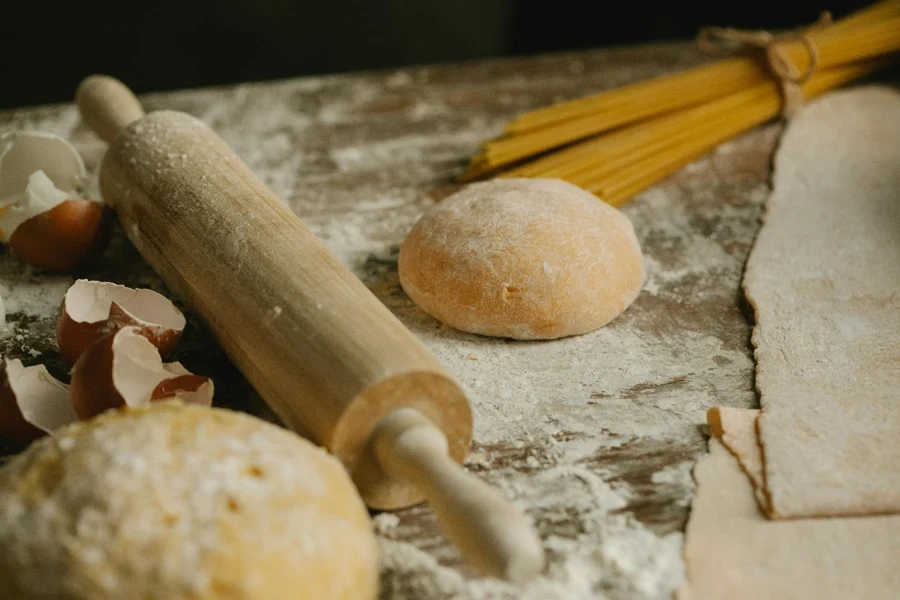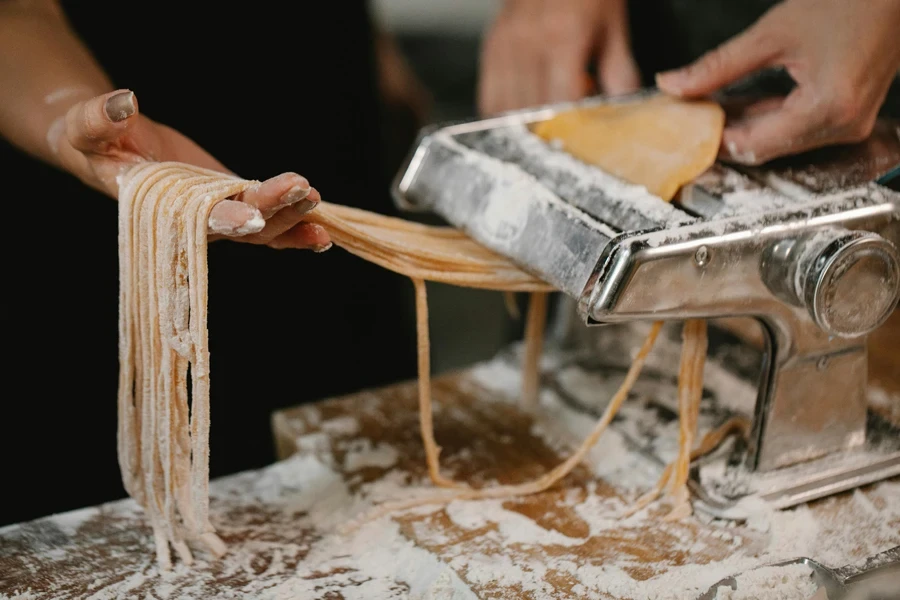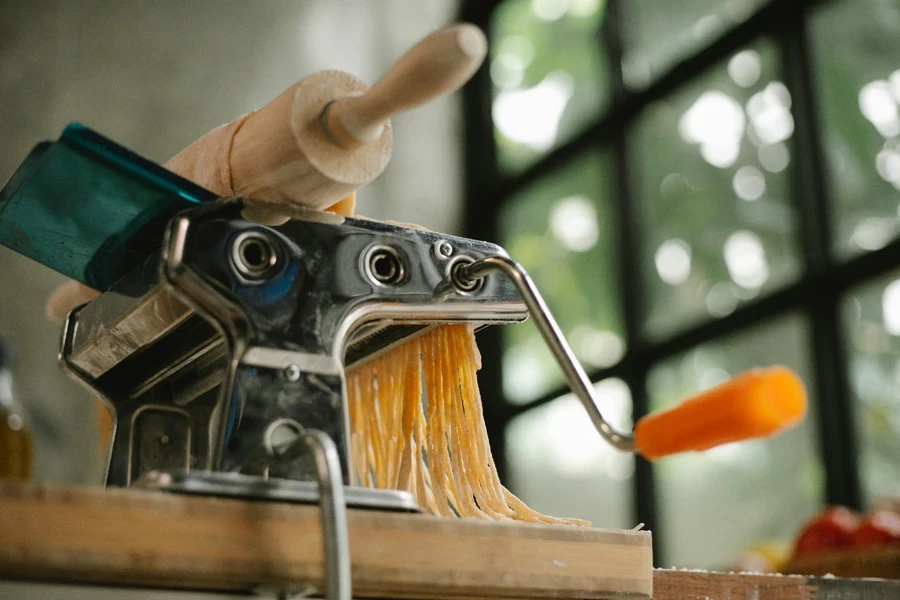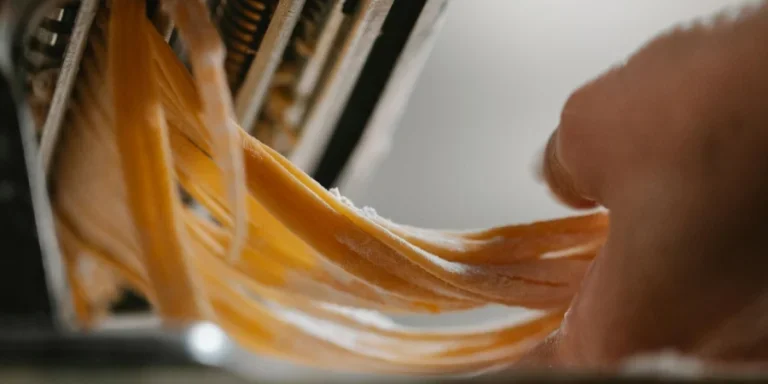Making pasta requires precision and the right tools to ensure high-quality results, a vital consideration in the growing pasta market. With consumer preferences shifting toward diverse shapes, gluten-free options, and artisanal trends, understanding market dynamics is crucial for professional buyers. The right pasta-making tools not only enhance production efficiency but also cater to evolving demands for creativity and consistency. This article explores key market insights, tool features, and considerations for selecting the best equipment to meet professional standards. By aligning with industry trends, businesses can craft superior pasta products that stand out in a competitive marketplace.
Table of Contents
● The rising demand for pasta: A market overview
● Tools for tradition: Crafting pasta in classic and modern styles
● Things to consider when selecting pasta-making tools
● Conclusion
The rising demand for pasta: A market overview

Market growth trends
The global pasta market has shown consistent growth, with a projected value increase from $71.42 billion in 2024 to $100.24 billion by 2032, according to Fortune Business Insights. This growth corresponds to a steady CAGR of 5.47% during the forecast period. Factors driving this expansion include the rising popularity of convenient and ready-to-eat food products, as well as increased consumer demand for gluten-free and vegan pasta options. The market’s resilience was particularly evident during the pandemic when consumers stockpiled long-lasting dried pasta varieties, showcasing its enduring appeal.
Dominant players in the market
Europe remains the largest contributor to the pasta market, accounting for 29.54% of global sales in 2023, as per Fortune Business Insights. This dominance is rooted in its cultural and culinary heritage, with Italy leading the way in premium pasta production. Meanwhile, the U.S. market is set to reach $12.96 billion by 2032, reflecting a shift toward convenience-focused options like pre-packaged and ready-to-cook products. Additionally, the Asia-Pacific region is emerging as a significant growth hub due to increasing urbanization and the adoption of Western dietary trends, particularly in China and India.
Emerging preferences
Shifting consumer habits are reshaping the pasta market landscape. The demand for gluten-free and vegan pasta has surged due to dietary preferences and health concerns, including celiac disease and increased environmental awareness. Fortune Business Insights highlights the growth of plant-based diets and organic pasta products as key drivers, with brands like Bona Furtuna and Jovial Foods introducing innovative offerings to cater to these preferences. This evolving landscape presents significant opportunities for manufacturers and suppliers to align their product portfolios with consumer trends.
Tools for tradition: Crafting pasta in classic and modern styles

Rolling pins for precise sheets
Rolling pins, such as the Mattarelli, are engineered with specific dimensions to meet the rigorous demands of hand-rolled pasta production. Typically measuring up to 100 cm in length and 3-4 cm in diameter, they are constructed from hardwoods like beech or maple, which resist warping and provide the ideal weight-to-surface ratio for applying even pressure. The fine texture of the wood interacts with dough in a way that maintains elasticity, ensuring uniform thickness as thin as 1 mm. For professional use, precision-turned rolling pins are preferred, as they offer enhanced stability and ease of handling.
Pasta wheels for intricate cuts
Pasta wheels, commonly crafted from food-grade brass or stainless steel, feature precision-machined blades that deliver clean cuts even in dense doughs. Fluted edges on high-quality models maintain consistent patterns, with depths ranging between 1-2 mm, ideal for creating decorative crimps on ravioli or farfalle. Multi-wheel cutters, like the bicicletta, are equipped with adjustable spacing mechanisms that allow users to customize noodle widths, enabling efficient production of parallel cuts for lasagna sheets or pappardelle. Advanced wheels often include self-lubricating mechanisms to reduce wear during high-frequency use.
Chitarra cutters for square strands
The chitarra, a traditional tool with modern refinements, employs high-tensile stainless steel wires that are pre-tensioned to precise tolerances, typically around 2 N/cm. These wires slice dough into square spaghetti strands with uniform dimensions, often 2 mm in width and 1.5 mm in thickness. The wooden frame, usually made from aged oak, provides structural integrity to withstand repetitive pressure without deformation. Modern chitarra designs include adjustable wire spacing, allowing for the production of varying strand widths tailored to different pasta recipes.
Hand-cranked pasta machines for versatility

Hand-cranked pasta machines incorporate hardened chrome-plated steel rollers, which ensure smooth, consistent flattening of dough without sticking. These rollers are coupled with precisely calibrated gears, enabling incremental adjustments of thickness, often ranging from 0.2 mm to 3 mm. Integrated cutters use hardened stainless steel blades for durability, and their alignment is fine-tuned during assembly to achieve clean, even edges. Premium models, such as those with ball-bearing crank systems, reduce manual effort, making them suitable for high-output applications in professional kitchens.
Electric extruders for complex designs
Electric extruders are designed with robust auger systems that generate consistent pressure to push dough through die plates. The extrusion force is calibrated, typically ranging between 10-15 bar, to ensure uniformity in shapes like fusilli, rigatoni, or bucatini. Bronze dies, which impart a rough texture for sauce adherence, are precision-engineered with micron-level accuracy, while Teflon-coated dies produce a smoother finish for dry pasta. Many models incorporate variable-speed motors, allowing for customization of extrusion rates to match dough consistency and desired output, with capacities often exceeding 1.5 kg per hour.
Corzetti stamps for embossed patterns
Corzetti stamps, crafted from precision-lathed brass or CNC-milled wood, provide detailed embossing patterns with depths ranging from 0.5 mm to 1 mm. These patterns increase surface area on pasta discs, enhancing sauce adherence and creating visually appealing designs. The cutting base of the stamp is honed to achieve a perfect circular edge, ensuring consistency across batches. Advanced models include interchangeable embossing plates, allowing chefs to vary designs for different culinary presentations.
Gnocchi boards for enhanced texture
Gnocchi boards, constructed from finely grooved hardwoods, have grooves spaced at precise intervals of 1-2 mm to create uniform ridges on pasta. The grooves are machined to specific depths, typically around 0.5 mm, optimizing their functionality for sauce retention without compromising the structural integrity of the dough. Boards often include ergonomic, contoured handles designed to reduce hand fatigue during extended use. High-end models undergo surface treatments that prevent dough adhesion, enhancing their usability and durability.
Pasta drying racks for quality preservation
Pasta drying racks are engineered with food-grade materials like stainless steel rods or treated hardwoods to ensure long-lasting performance. The rods are spaced at intervals of 10-15 cm to maximize airflow around pasta strands, promoting even drying and preventing clumping. Advanced racks include rotating bases or height-adjustable arms to accommodate different pasta lengths. For professional applications, collapsible racks with reinforced joints are preferred, as they combine portability with the capacity to handle large batches, often exceeding 2 kg of pasta at a time.
Things to consider when selecting pasta-making tools

Purpose and usage
When selecting pasta-making tools, it is essential to match the equipment to the intended pasta shapes and production goals. For instance, gnocchi boards are specifically designed to create grooves that enhance sauce adherence, making them ideal for textured shapes like gnocchi and cavatelli. Extruders, on the other hand, are necessary for producing tubular pasta such as penne or rigatoni, where consistency in shape is critical. Tools like corzetti stamps add decorative patterns to pasta, catering to chefs focused on presentation, while hand-cranked machines offer versatility for both sheeted and shaped pasta production.
Skill level and learning curve
Different tools cater to varying levels of expertise. For beginners, basic tools like rolling pins and gnocchi boards are intuitive and require minimal training, making them suitable for small-scale production. Conversely, hand-cranked machines with adjustable settings demand a moderate learning curve but offer the ability to create multiple pasta types with precision. Professional-grade electric extruders and chitarra cutters are more suitable for experienced users or commercial settings, as they require knowledge of dough consistency and equipment handling to achieve optimal results.
Kitchen space and storage
The size of the kitchen and available storage are critical factors when choosing pasta tools. Compact tools such as foldable drying racks and multi-functional cutters are ideal for small spaces, as they minimize clutter without sacrificing utility. Electric extruders, while efficient, often require dedicated counter space, making them better suited for larger kitchens or commercial environments. Hand-cranked machines, with their clamp-based designs, are versatile for various kitchen setups and can be stored easily when not in use.
Budget considerations
Budget constraints influence whether to opt for high-end or entry-level tools. Investment-worthy tools, such as the Marcato Atlas hand-cranked machine, provide durability and versatility, making them cost-effective for frequent use. For occasional pasta makers, more affordable options like basic rolling pins or plastic gnocchi boards may suffice. Advanced tools like electric extruders, which streamline production, represent a higher upfront cost but are valuable for those prioritizing efficiency and consistency.
Material preference
The material of pasta tools affects both functionality and maintenance. Traditional wooden tools, such as gnocchi boards and corzetti stamps, offer an artisanal feel and are ideal for creating textured pasta. However, they require specific care to prevent damage from moisture. Stainless steel tools, including pasta wheels and electric machine components, are easier to clean and maintain, making them better suited for heavy or frequent use. For users balancing tradition with modern convenience, hybrid tools combining wooden aesthetics with stainless steel durability are a practical choice.
Conclusion

Selecting the right pasta-making tools is critical for achieving efficiency, consistency, and creativity in pasta production. By understanding the unique features and applications of each tool, businesses can align their choices with their operational needs, skill levels, and production scales. From traditional methods to advanced technologies, the right equipment ensures precision and quality, enabling manufacturers and culinary professionals to meet diverse market demands with confidence.




